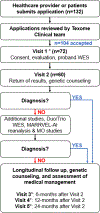Improving access to exome sequencing in a medically underserved population through the Texome Project
- PMID: 38431799
- PMCID: PMC11161315
- DOI: 10.1016/j.gim.2024.101102
Improving access to exome sequencing in a medically underserved population through the Texome Project
Abstract
Purpose: Genomic medicine can end diagnostic odysseys for patients with complex phenotypes; however, limitations in insurance coverage and other systemic barriers preclude individuals from accessing comprehensive genetics evaluation and testing.
Methods: The Texome Project is a 4-year study that reduces barriers to genomic testing for individuals from underserved and underrepresented populations. Participants with undiagnosed, rare diseases who have financial barriers to obtaining exome sequencing (ES) clinically are enrolled in the Texome Project.
Results: We highlight the Texome Project process and describe the outcomes of the first 60 ES results for study participants. Participants received a genetic evaluation, ES, and return of results at no cost. We summarize the psychosocial or medical implications of these genetic diagnoses. Thus far, ES provided molecular diagnoses for 18 out of 60 (30%) of Texome participants. Plus, in 11 out of 60 (18%) participants, a partial or probable diagnosis was identified. Overall, 5 participants had a change in medical management.
Conclusion: To date, the Texome Project has recruited a racially, ethnically, and socioeconomically diverse cohort. The diagnostic rate and medical impact in this cohort support the need for expanded access to genetic testing and services. The Texome Project will continue reducing barriers to genomic care throughout the future study years.
Keywords: Access to genomic medicine; Diagnostic odyssey; Exome sequencing; Genetic testing; Under-represented populations.
Copyright © 2024. Published by Elsevier Inc.
Conflict of interest statement
Conflict of Interest Lilei Zhang owns equity and consults for Pelagos Pharmaceuticals, Inc. Scott McLean is a medical consultant for Face2Gene. Baylor College of Medicine (BCM) and Miraca Holdings Inc have formed a joint venture with shared ownership and governance of Baylor Genetics (BG), which performs genetic testing and derives revenue. Pengfei Liu is an employee of BCM and derives support through a professional services agreement with BG. All other authors declare no conflicts of interest.
Figures



References
Publication types
MeSH terms
Grants and funding
LinkOut - more resources
Full Text Sources
Medical

